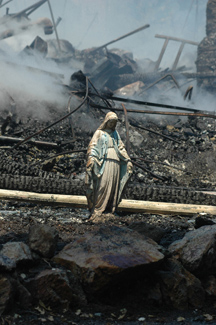St. Francis begins collecting funds for a new vision of the
retreat center
On a balmy Sunday afternoon recently some 60 people gathered
under the sheltering oaks near a pond at St. Francis Retreat
outside San Juan Bautista.
St. Francis begins collecting funds for a new vision of the retreat center
On a balmy Sunday afternoon recently some 60 people gathered under the sheltering oaks near a pond at St. Francis Retreat outside San Juan Bautista.
Some of the oaks were probably standing when the first Europeans arrived in San Juan Bautista in the 1790s. It was the Roman Catholic Church that brought them to the area, and they founded Mission San Juan Bautista in 1797.
But the handpicked group gathered on the property at the end of a quiet lane off Mission Vineyard Road were not there to remember the past. They are among the first being asked to consider the future.
Mingling or sitting in neat rows of folding chairs, the group at St. Francis was there to look over preliminary plans for a new retreat center, one the Franciscan Fathers of California who operate the venerable center hope will rise phoenix-like, from the ashes of the historic center of the retreat that burned a year ago.
It was before dawn on June 23, 2006, when what is believed to be an electrical fire raced through the retreat’s main building, an enormous wooden Victorian structure. By first light the building lay in glowing embers. Miraculously, the fire neither spread to the retreat center’s other buildings or to the tinder dry hillsides nearby.
The heart of the retreat was the Flint House, completed when Abraham Lincoln was still in office in 1863, using both locally milled lumber and wood shipped on sailing ships around Cape Horn.
California at the time was still largely a wilderness. The house was the center of a vast ranching estate, Rancho San Justo. It also was the gem of one of California’s most powerful partnerships, the Flint-Bixby and Co. The partnership also had holdings near Bakersfield and once owned all of what is now Long Beach and Signal Hill in Southern California.
The Franciscans purchased the house and 73 acres surrounding it in 1947, and soon opened a retreat center that has operated continuously since. It contains conference rooms holding up to 150, lodging, a chapel, offices and housing for the staff. Its setting nestled in a dell in the Gabilans above San Juan Bautista contains native plant gardens, walking paths and places to invite meditation and quiet conversation.
The retreat staff is still in the early stages of planning an event to mark the retreat’s 60th anniversary in December of this year.
At the quiet inaugural event, visitors reviewed sign boards showing renderings of new gardens and buildings. The buildings evoke early California and fit in better with the chapel and “Casita” building that survived last year’s fire.
All these dreams come at a cost, an estimated $5.7 million.
“It’s huge,” said Ed. DeGroot, the retreat’s business manager. “We’re fighting to stay there.”
Coming on the heels of a capital campaign in the local Catholic community that led to the dedication of St. Benedict’s Church off Fairview Road in 1999, DeGroot said the staff recognizes that the campaign will have to approach a wider community.
Only half of the 7,000 visitors to the retreat each year are Catholic, DeGroot said. The center is used for nonprofit and business gatherings as well.
While the retreat continues to function using temporary structures – a kitchen recently re-opened on site – the reduction in capacity has turned what once helped support the Franciscan Fathers into an operation that barely breaks even.
“We went from being able to host 135 guests to 110,” DeGroot said. “If I lose the 25 people [the difference between the former facility and temporary accommodations] I lose my profit.”
Plans call for a new approach, one respecting the property’s significant natural value.
New structures will employ passive heating and cooling design elements, capturing winter sun and using wide eaves to shield structures from the summer rays. Windows will open. Plans call for building materials from rapidly renewable resources, primarily harvested and extracted locally. Recycled content will be emphasized, according to the materials potential donors received last month.
The vision calls for a wetland-pond treatment system for water reclamation, and an on-site pre-treatment system for waste water. Drip irrigation will flow by gravity.
While landscaping emphasizes native plants and the existing oaks, plans call for a cutting and herb garden as well. Produce from the garden will go into the meals served at the retreat center.
The retreat employs 21 people, with three full-time volunteers also on staff. Three friars are directly involved in the center.










